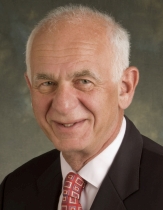 G. Michael Halmagyi |
 Geoffrey D. Parker |
We chose this topic following the pioneering work of our colleague Dr. Ian Johnston, an eminent neurosurgeon who has struggled to unravel pseudotumor cerebri (PTC) for 40 years now.1 Our first success was in the late 1990s, when we treated a patient with PTC who had transverse sinus stenosis with balloon angioplasty. This patient had complete resolution of symptoms for several months before again becoming symptomatic.
We were also interested in the possible significance of giant arachnoid granulations in the pathogenesis of PTC, particularly after they were erroneously considered to be an incidental finding.2 Dr. Johnston provided a surgical specimen of a giant arachnoid granulation after resection of the transverse sinus for a dural arteriovenous fistula, and we published the results of histologic examination.3 We erroneously concluded that there was a heterotopic brain tissue within the granulation, but subsequent examination of the original slides showed that there was actually a large hernia of brain tissue into the granulation, expanding it. Another neurosurgeon, Dr. Michael Besser, then told us that small hernias of brain tissue into the stalk of an arachnoid granulation from the subarachnoid space were commonly seen during craniotomies.
At this point, “the penny dropped,” and we understood how rising intracranial pressure could enlarge a giant arachnoid granulation by enlarging the brain hernia, and this could then lead to increased venous sinus obstruction and upstream venous hypertension, with decreased CSF absorption and prolongation of elevated CSF pressure in defiance of normal negative feedback control of CSF pressure.
We realized that an abnormal positive feedback loop was operating in these patients with PTC, with venous hypertension leading to CSF hypertension and then further venous hypertension. We were then able to replicate this mechanism with a multicompartment mathematical model, following the work of Stevens et al.4 We were able to extend this understanding to patients with PTC and extrinsic transverse sinus stenoses due to collapsible sinuses (Starling resistors) and were able to understand why the conclusions of King et al,5 that the venous stenoses were simply secondary to raised intracranial pressure (and therefore should not be treated), were erroneous. It became clear that when one is faced with a positive feedback loop or a “vicious cycle,” the loop just needs to be broken and the answer to the question of causation becomes irrelevant—rather like the question of which came first: the chicken or the egg.
Since our publication, we have continued to stent the transverse sinus in patients with intractable PTC. We are now up to 127 patients, and as far as we can tell, there has been only one patient shunted for PTC at our hospital during this period.